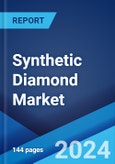Synthetic diamonds are man-made or laboratory-grown diamonds generally manufactured by subjecting graphite under high-pressure, high-temperature (HPHT) and chemical vapor deposition (CVD) methods. They are widely used as hard coatings for industrial equipment, such as wire-drawing dies, quarrying saws, grinding wheels, machine tools, and mining drills.
Unlike natural diamonds, synthetic diamonds are produced under precisely regulated circumstances, have fewer flaws, and exhibit limited indications of strain in their crystal structure. Apart from this, they exhibit hardness, electron mobility, and thermal conductivity, due to which they find extensive applications across the construction, electronics, mining, and oil and gas industries.
Synthetic Diamond Market Trends:
Significant growth in the electronics industry across the globe is creating a positive outlook for the market. Synthetic diamonds are widely used in high-power switches at power plants, high-frequency field-effect transistors, and light-emitting diodes (LEDs). In line with this, the widespread product adoption in telecommunications, due to its high refractive index with minimized information loss during high-level-security signal transmission, is favoring the market growth. Apart from this, synthetic diamonds are sustainable and free of unethical mining, which, in turn, is providing an impetus to the market growth.Furthermore, the extensive product utilization in various industrial applications, such as manufacturing machines and computer chips, mining, medical procedures, space science, and stone cutting, is acting as another growth-inducing factor. Besides this, the growing popularity of synthetic diamonds as an alternative to natural diamonds owing to their eco-friendliness, rising disposable incomes of consumers, and widespread product incorporation in UV (ultraviolet) light or high-energy particle detectors are anticipated to drive the market toward growth.
Key Market Segmentation:
This report provides an analysis of the key trends in each segment of the market, along with forecasts at the global, regional, and country levels for 2025-2033. Our report has categorized the market based on type, manufacturing process, and application.Breakup by Type:
- Polished
- Rough
Breakup by Manufacturing Process:
- High Pressure High Temperature
- Chemical Vapor Deposition
Breakup by Application:
- Gem
- Heat Sinks and Exchangers
- High-End Electronics
- Laser and X-Ray
- Machining and Cutting Tools
- Surgical Machinery
- Water Treatment
- Medical
- Optical
- Others
Breakup by Region:
- North America
- United States
- Canada
- Asia-Pacific
- China
- Japan
- India
- South Korea
- Australia
- Indonesia
- Others
- Europe
- Germany
- France
- United Kingdom
- Italy
- Spain
- Russia
- Others
- Latin America
- Brazil
- Mexico
- Others
- Middle East and Africa
Competitive Landscape:
The competitive landscape of the industry has also been examined along with the profiles of the key players being Applied Diamond Inc., D.NEA, Element Six (UK) Ltd., Finegrown Diamonds, Henan Huanghe Whirlwind Co. Ltd, Henan Liliang Diamond Co. Ltd., Heyaru Engineering Pvt. Ltd., Hyperion Materials & Technologies Inc., Iljin Diamond Co. Ltd., Industrial Abrasives Ltd, New Diamond Technology, Soham Industrial Diamonds, Swarovski AG and Zhengzhou Sino-Crystal Diamond Co. Ltd.Key Questions Answered in This Report:
- What was the size of the global synthetic diamond market in 2024?
- What is the expected growth rate of the global synthetic diamond market during 2025-2033?
- What are the key factors driving the global synthetic diamond market?
- What has been the impact of COVID-19 on the global synthetic diamond market?
- What is the breakup of the global synthetic diamond market based on the manufacturing process?
- What is the breakup of the global synthetic diamond market based on the application?
- What are the key regions in the global synthetic diamond market?
- Who are the key players/companies in the global synthetic diamond market?
Table of Contents
Companies Mentioned
- Applied Diamond Inc.
- D.NEA
- Element Six (UK) Ltd.
- Finegrown Diamonds
- Henan Huanghe Whirlwind Co. Ltd
- Henan Liliang Diamond Co. Ltd.
- Heyaru Engineering Pvt. Ltd.
- Hyperion Materials & Technologies Inc.
- Iljin Diamond Co. Ltd.
- Industrial Abrasives Ltd
- New Diamond Technology
- Soham Industrial Diamonds
- Swarovski AG
- Zhengzhou Sino-Crystal Diamond Co. Ltd.
Table Information
| Report Attribute | Details |
|---|---|
| No. of Pages | 147 |
| Published | April 2025 |
| Forecast Period | 2024 - 2033 |
| Estimated Market Value ( USD | $ 17.1 Billion |
| Forecasted Market Value ( USD | $ 30.2 Billion |
| Compound Annual Growth Rate | 6.5% |
| Regions Covered | Global |
| No. of Companies Mentioned | 14 |









